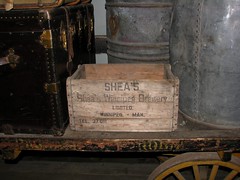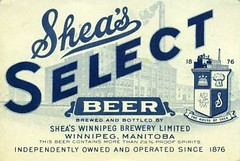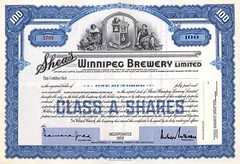© 2012 Christian Cassidy
Each February, Anheuser-Busch's Clydesdales get some pricey air time during the Superbowl. This year was no different.
On a couple of occasions I have come across references to the fact that the original Anheuser-Busch Clydesdale teams came from Winnipeg, most recently in the documentary Beer Barons of Winnipeg. I thought I would dig into the story a little further.
The story begins in the 1880s with a man named Patrick Shea. He was born in Co. Kerry, Ireland on March 7, 1854, and trained as an engineer. He came to North America to in 1870 work on railway infrastructure projects and eventually settled in Manitoba in 1882.
From 1882 to 1884, Shea was in charge of the water distribution system for the railway construction from Oak Lake westward. When that job was completed he decided to put down roots in Winnipeg.
Shea met fellow Irishman John McDonagh and together they purchased the Waverley Hotel near Higgins and Main. They became well-known for their hospitality and it became a popular watering hole.
Around this time he also met and married Margaret Burns of Winona, Minnesota. They married and had five children together, though only two survived childhood.
The two men decided to leave the hotel business in 1887 after purchasing from Sylvester Thomas the assets of his defunct and run-down Winnipeg Brewery on Colony Street at Broadway for $16,000. Others had leased the facility from Thomas to try and make a go of it but couldn't. McDunough and Shea, which is what the new enterprise was called, found success.
McDonagh died in 1893 leaving Shea the sole owner. Shea kept the "McDonagh and Shea" business name until 1926 when the brewery had to be reincorporated due to the province's new liquor production rules. It then became known as "Shea's Winnipeg Brewery Ltd." (The Winnipeg Brewery was established in 1873 and Shea's would later use that in its advertising and on its labels as the year it was founded.)
On a couple of occasions I have come across references to the fact that the original Anheuser-Busch Clydesdale teams came from Winnipeg, most recently in the documentary Beer Barons of Winnipeg. I thought I would dig into the story a little further.
The story begins in the 1880s with a man named Patrick Shea. He was born in Co. Kerry, Ireland on March 7, 1854, and trained as an engineer. He came to North America to in 1870 work on railway infrastructure projects and eventually settled in Manitoba in 1882.
From 1882 to 1884, Shea was in charge of the water distribution system for the railway construction from Oak Lake westward. When that job was completed he decided to put down roots in Winnipeg.
Shea met fellow Irishman John McDonagh and together they purchased the Waverley Hotel near Higgins and Main. They became well-known for their hospitality and it became a popular watering hole.
Around this time he also met and married Margaret Burns of Winona, Minnesota. They married and had five children together, though only two survived childhood.
The two men decided to leave the hotel business in 1887 after purchasing from Sylvester Thomas the assets of his defunct and run-down Winnipeg Brewery on Colony Street at Broadway for $16,000. Others had leased the facility from Thomas to try and make a go of it but couldn't. McDunough and Shea, which is what the new enterprise was called, found success.
McDonagh died in 1893 leaving Shea the sole owner. Shea kept the "McDonagh and Shea" business name until 1926 when the brewery had to be reincorporated due to the province's new liquor production rules. It then became known as "Shea's Winnipeg Brewery Ltd." (The Winnipeg Brewery was established in 1873 and Shea's would later use that in its advertising and on its labels as the year it was founded.)
Shea's Brewery ca. 1930s
Shea became a well-liked community leader and philanthropist. A Tribune story after his death called him "a smiling, kindly, big-hearted boniface."
Business was good and in in 1903 the brewery underwent the first of many major expansions at the Colony Street site, eventually becoming the city's largest brewery.
At the time Shea's was created, the only method of urban transportation for the fire department, streetcars or product delivery, was horse power. Different companies had their preferred breed of horse. Eaton's and Crescent Creamery used Hackneys while Manitoba Cartage and Shea's preferred Clydesdales.
Horses were a major investment for these companies. There could be more horses working for an organization than people and the amount of space needed to keep and care for them often exceeded the footprint of the building that they served. An 1882 Free Press article notes that Manitoba Cartage was building "extensive new stables" for their 42 six-horse teams!
An impressive horse or team was also good for a company's public image. Many showed their best animals and fanciest wagons in competition and a few even became local celebrities in their own right.
Shea spared no expense when it came to this aspect of the company's image. He was an active Clydesdale breeder and regularly imported champion horses directly from Scotland to keep the bloodlines strong. Shea also had special show wagons built at a cost of $2,000 each.
The investment paid off as many of Shea's horses and teams won top prizes at horse shows and fairs in Brandon, Toronto, Minneapolis, and Chicago.
"Aladdin", one of Shea's veterans, took top prize in his class and was overall grand champion at the Chicago International Livestock Show of 1927. At the same show, along with another horse called Unity, Aladdin also won top in class for best team. The image above shows "Warrior" who arrived from Scotland in March 1928 and took top honours in his class at Brandon and Toronto in years to come.
Another Winnipeg firm, Manitoba Cartage, took similar interest in their Clydesdales and Manitoba's Clydesdale industry had a stellar international reputation. In fact, the Brandon Winter Fair's Clydesdale show was considered one of the best on the continent.
The era of the horse-drawn wagon began to give way to motorized vehicles after World War I and hundreds of horses were put out to pasture each year. Companies such as Eaton's, Manitoba Cartage and Shea's kept their best teams 'on the payroll' and continued to show them.
In the early years of the Depression an aging and ill Patrick Shea decided to sell off his prized teams. He accepted an offer for one of them while at the 1933 Toronto Winter Fair. A brief Free Press story noted that the purchaser was "a St. Louis brewery."
That St. Louis brewery was Anheuser-Busch, North America's largest, and brewers of the popular Budweiser beer. "Bud" had been available in Winnipeg since around 1904 when the Hudson Bay Company began distributing it in Western Canada.
At the Clydesdale section of the A-B website, it notes: "Realizing the marketing potential of a horse-drawn beer wagon....on April 7, 1933, August A. Busch, Jr. and Adolphus Busch III surprised their father, August A. Busch, Sr., with the gift of a six-horse Clydesdale hitch..."
The website does not mention the Winnipeg connection, though many news stories about the Clydesdales on tour, such as here, here, and here, contain a paragraph similar to: "The Cyldesdales became part of the Budwesier and Anheuser-Busch Brewing story in 1933. August A. Busch Jr. bought the first team of Anheuser-Busch Clydedales from Patrick Shea of Shea's Brewery in Winnipeg, Manitoba, Canada. Jr. then hitched the team up and brought them to the family brewery in St. Louis to greet his father, August Anheuser Busch, Sr...."
This suggests that company news releases about their appearance do mention Shea.
The A-B website goes on to say that August Sr. was pleased with the gift and the following year his company purchased more Clydesdales. This was likely more of Shea's Clydesdales and wagons that were sold off at the 1934 Royal Guelph Winter Show.
July 10, 1933, Winnipeg Free Press
Shea spent most of the early months of 1933 travelling to various U.S. clinics in the hopes to find a cure for what newspapers would only describe as a "lingering illness". He died at his home at 140 Colony Street on July 8, 1933 at the age of 80.
Shea's funeral at St. Mary's Cathedral drew hundreds of mourners. Winnipeg beer parlours closed in his honour on the morning of his funeral.
Top: Pat, Margaret Shea. Bottom: Frank Shea, John Boyd
Control of Shea's Brewery went to his widow, Margaret, and their only surviving child, Frank, who had worked at the company since 1904. (Their other son, Paul, died from a burst appendix whilst a student at Fordham University in New York in 1917 at the age of 21.)
Frank became company president though his tenure would last just a few months. He had long suffered from a from a "nervous condition", which was usually code in those days for mental illness. (One researcher told me that alcoholism may have been an issue as well.)
In early 1932, Frank had what was described in newspapers as a "severe nervous breakdown" and the strain of losing his father had just worsened matters. At the end of July 1933, he was sent to the U.S. and admitted to Johns Hopkins Hospital in Baltimore for treatment.
Frank Shea died suddenly at the hospital on October 20, 1933, at the age of 44.
Margaret Shea then became the majority shareholder in the company. By this time, though, Shea's was a mature business with a full executive team and over 100 staff, and the transition from her son to hers was an easy one.
The brewery was run by John T. Boyd from 1934 to 1950. He was a long-time executive who started out as an office boy when the brewery first opened. During his tenure, Shea's assumed control of two other local breweries - Pelissier's and Kiewel's. It also ran the beer distribution firm Brewery Products Ltd. and had a controlling interest in 41 of Manitoba's 260 hotels.
Margaret Shea kept up her husband's philanthropic ways by donating to many funds and hosting many events to raise money for hospitals, schools, and charities. For instance, in the 1930s she largely funded the construction of a new hall (named for son Paul) for high school students at St. Paul's College on Ellice Avenue and there was the Lady Margaret Shea scholarship at St. Mary's Academy.
When Margaret died on April 13, 1950 at the age of 91, she bequeathed over $50,000 to various charities, including St. Paul's and St. Mary's.
Upon the death of Margaret, the Shea estate was left to Frank's widow, Ethel Shea.
Initially, it appeared that Ethel got a windfall as the estate was valued at $3 million. Most of that, however, was in company stock and the federal government claimed half of it in succession duties, (now called inheritance tax). There was only around $300,000 in cash which meant Ethel probably had to sell off a lot of stock and any real estate in the portfolio.
When Ethel died in 1952, she left 33,000 shares each to the General Hospital and Misericordia Hospital. This put the institutions, particularly the Catholic-run Misericordia hospital, in the uncomfortable position of being the brewery's largest combined shareholder. When added to the shares owned by the Boyd estate, the three had controlling interest in the company.
The hospitals were eager to divest themselves of their shares and the Boyd family also wanted to sell up. That's when Labatt's was called on. (I have been told that it was the family's expressed wishes that if the shares were ever to be sold, it would be to Labatt's and not a competitor.)
December 12, 1953, Winnipeg Free Press
In December 1953, Hugh Labatt announced that his company's offer to purchase the 91% stake in Shea's Brewery owned by the hospitals and Boyd family was overwhelmingly accepted. Manitoba's oldest and largest brewery was now in Eastern hands.
Each hospital ended up making over $1 million, (about $8.5 m in 2012 dollars). The General Hospital put its funds toward the construction of a new Children's Hospital in 1956. The Misericordia put its money toward the construction of its Cornish Wing in 1957.
The Shea's Brewery building on Colony Street (located in what is now the rear parking lot of Great West Life) was converted to a Labatt Brewery facility. It suffered a major fire in 1975 and was torn down in 1979.

Related:
Most of the above information was pieced together from a few dozen newspaper articles. Here are some online sources pertaining to Shea's:
- Alcohol and temperance in modern history Blocker, Fahey, Tyrrell
- Brewed in Canada A. W. Sneath
- Shea's Winnipeg Diamond Jubilee Booklet
- Horse Show Memories Winnipeg Diamond Jubilee Booklet
- Thanks to beer historian Bill Wright who is writing a book about the history of Manitoba's breweries.
Most of the above information was pieced together from a few dozen newspaper articles. Here are some online sources pertaining to Shea's:
- Alcohol and temperance in modern history Blocker, Fahey, Tyrrell
- Brewed in Canada A. W. Sneath
- Shea's Winnipeg Diamond Jubilee Booklet
- Horse Show Memories Winnipeg Diamond Jubilee Booklet
- Thanks to beer historian Bill Wright who is writing a book about the history of Manitoba's breweries.






























15 comments:
Interesting. Well researched.
Remarkable!
Thanks !
I asked at the ebrandon forums if Clydesdales are still big in Westman. Turns out there are some top breeders there and A-B still buys Clydes and hires horsemen from the area ! http://www.ebrandon.ca/messagethread.aspx?message_id=597579&cat_id=57
great stuff....another interesting story connecting winnipeg and busch is the long standing battle between standard lager (first carling and then molson) and the Budweiser logo copyright....
http://www.marquedor.com/telemarque/annee2010/vol17no4d_detail_en.html
http://trademarkblog.ca/beer-trademarks-and-the-jurisdiction-of-the-opposition-board/
http://www.marquedor.com/telemarque/annee2010/vol17no4d_detail_en.html
sorry...bad link
Thanks Brent. Interesting stuff. I guess when these breweries started they never figured they'd get as big as they would so they could "borrow" from each other and not have to worry about it !
This is the first that I've heard of the connection - very interesting stuff! Makes one wonder how things might have played out had Shea's kept them and incorporated them into their own marketing the way Busch did.
so the good ole religious sisters of misericordia used beer money to build part of their hospital how ironic haha...good to know...i don t remember seeing any of that posted in their history books lol..truth is stranger than fiction
The Clydesdale is an amazing, gentle, huge, gorgeous equine. I just adore them. It is heartbreaking though to see that some, including Budweiser, still mutilate their horses. Why do people still do this brutal, horrific act? They hack off their tails, not just the hair but vertebrae, nerves, muscles and skin. HORRIFYNG!!
Uninformed folks think it is to prevent tails from interfering with the harness...it is not. It is just an archaic, pointless, cosmetic mutilation.
See what AAEP says: “THE AMERICAN ASSOCIATION OF EQUINE PRACTITIONERS CONDEMNS THE ALTERATION OF THE TAIL OF THE HORSE FOR COSMETIC OR COMPETITIVE PURPOSES.”
THE AAEP URGES ALL BREED ASSOCIATIONS AND DISCIPLINES TO ESTABLISH AND ENFORCE GUIDELINES TO ELIMINATE THESE PRACTICES AND TO EDUCATE THEIR MEMBERSHIP ON THE HORSE HEALTH RISKS THEY MAY CREATE. MEMBERS OF AAEP SHOULD EDUCATE THEIR CLIENTS ABOUT THE POTENTIAL HEALTH RISKS, WELFARE CONCERNS, AND LEGAL AND/OR REGULATORY RAMIFICATIONS REGARDING THESE PROCEDURES BASED ON THE RELEVANT JURISDICTION AND/OR ASSOCIATION RULES.”
Here is a link to my petition: https://www.change.org/p/carlos-brito-kees-storm-anheuser-busch-budweiser-beer-i-want-budweiser-to-stop-mutilating-their-horses
Thank you for sharing this remarkable local history. Once again you prove yourself a wonderful researcher and writer of local history!!
Hi Christian:
I posted this on the MHS Site previously. It ties into the use of the heavy-horses and the paved Cobble-stone Streets that Winnipeg had at one time...I suspect that the horses used on Fire Wagons would have benefited from this paving-stone/horse-shoe combination as well especially due to the City's notoriously muddy Streets.
Cheers, R.M. Ginter
https://hoofcare.blogspot.ca/2015/02/horses-traction-history-why-city-cobblestones-036.html
Fascinating story. Two years ago, I received permission from the City to salvage the oak from the historic Oak Room in St Regis Hotel in downtown Wpg. I spend a week in the hotel carefully extracting the 1911 oak artifacts, which were destined for a micro-distillery which was in the planning stages at that time. One of the things I found behind an oak panel was a long forgotten Shea's bottle opener. Curious about the history of the opener, I found your blog on Shea's and the link to the AB Clydesdales.
The Micro-distillery has come to fruition. It is called Patent 5 (named after the 5th patent issued to the Dominion of Canada in 1869). It is housed in Dominion Express Building - 1904 carriage house and livery stable at 108 Alexander Ave. As promised to the City, the St Regis Oak Room has been carefully re-purposed inside our cocktail bar and looks fantastic.
My reason for posting here is, I would like to edit/print and share the contents of your blog with our patrons, as it make a great story tying together many elements of our space.
Cheers,
Michael
My family were among the first to import Clydesdales from their farm near Port Glasgow Scotland to the new farm location north of Portage la Prairie. I suspect that some of the Shea Brewery horses were among those that were raised on that farm, and possibly some of those horses were among the first used by the AB brewery which ultimately became Budweiser.
If you know of any of the names of the Shea horses I would be able to track them through the Scottish Clydesdale registry.
Wonderfully calm and loving horses they are.
Brian
November 18, 2019 T 7.58 pm MST
Hi, fascinating! I hope someone will make a Horse calendar about these horses!
I remember Shea's very well...when you drove up, an attendant would come and get your empties for you,ask what you wanted and then brought it to you.
Good beer too.
Post a Comment